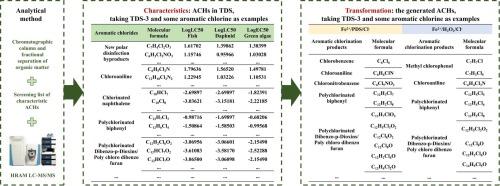探讨纺织印染污泥在Fe2+基化学处理过程中芳香族卤化化合物的特性及其转化
IF 11.3
1区 环境科学与生态学
Q1 ENGINEERING, ENVIRONMENTAL
引用次数: 0
摘要
印染污泥的化学处理是印染污泥脱水处理的重要环节。然而,在这一过程中,芳香族卤化化合物(AHCs)的动态变化和环境风险仍然知之甚少。本研究结合有机物分式分离、非靶向鉴定(non-targeted identification, HRMS)和AHCs筛选表对TDS中具有代表性的AHCs进行鉴定,并采用Fe2+/过氧硫酸盐(Fe2+/PDS)和Fe2+/H2O2处理系统探索这些典型AHCs在TDS中的转化。该筛选方法在三个原始TDS样品中鉴定出49-59种芳香烃氯化物和39-48种芳香烃溴化物,其中存在多氯萘、多氯联苯(PCBs)和多氯二苯并对二恶英/呋喃等在废水二次处理过程中可能产生的有害化合物。TDS氧化处理的结果表明,化学处理期间总有机卤素含量开始升高,但在30 min后下降。价/过氧化氢/ Cl - 140 mM;1/1)与Fe2+/PDS/Cl-(140 mM;1/1)。然而,这两种处理都引发了高卤化和有毒副产品的形成,特别是多氯联苯和六氯苯——禁止使用和生产的物质。本研究为评价TDS化学调理和不完全焚烧过程的环境风险提供了理论基础。本文章由计算机程序翻译,如有差异,请以英文原文为准。

Exploring the characteristics and transformation of aromatic halogenated compounds in textile dyeing sludge during Fe2+-based chemical treatment
The chemical conditioning of textile dyeing sludge (TDS) is an essential step in its dehydration and treatment. However, the dynamic changes and environmental risks associated with aromatic halogenated compounds (AHCs) during this process remain poorly understood. In this study, representative AHCs in TDS were identified by combining organic matter fractional separation, non-targeted identification (HRMS) and AHCs screening list, and the transformation of these typical AHCs in TDS was systematically explored by using Fe²⁺/peroxysulfate (Fe2+/PDS) and Fe2+/H2O2 treatments. This screening approach identified 49–59 aromatic chlorides and 39–48 aromatic bromides in three original TDS samples, with the presence of hazardous compounds like polychlorinated naphthalenes, polychlorinated biphenyls (PCBs), and polychlorinated dibenzo-p-dioxins/furans that may be generated during the secondary treatment of wastewater. The results of TDS oxidation treatment showed that the total organic halogen content initially increased during chemical conditioning but decreased after 30 min. Fe2+/H2O2/Cl- (140 mM; 1/1) demonstrated superior efficiency in reducing total organic chlorine compared to Fe2+/PDS/Cl- (140 mM; 1/1). However, both treatments triggered the formation of highly halogenated and toxic byproducts, particularly PCBs and hexachlorobenzene—substances banned from use and production. This study provides a theoretical foundation for evaluating the environmental risks associated with TDS chemical conditioning and incomplete incineration processes.
求助全文
通过发布文献求助,成功后即可免费获取论文全文。
去求助
来源期刊

Journal of Hazardous Materials
工程技术-工程:环境
CiteScore
25.40
自引率
5.90%
发文量
3059
审稿时长
58 days
期刊介绍:
The Journal of Hazardous Materials serves as a global platform for promoting cutting-edge research in the field of Environmental Science and Engineering. Our publication features a wide range of articles, including full-length research papers, review articles, and perspectives, with the aim of enhancing our understanding of the dangers and risks associated with various materials concerning public health and the environment. It is important to note that the term "environmental contaminants" refers specifically to substances that pose hazardous effects through contamination, while excluding those that do not have such impacts on the environment or human health. Moreover, we emphasize the distinction between wastes and hazardous materials in order to provide further clarity on the scope of the journal. We have a keen interest in exploring specific compounds and microbial agents that have adverse effects on the environment.
 求助内容:
求助内容: 应助结果提醒方式:
应助结果提醒方式:


